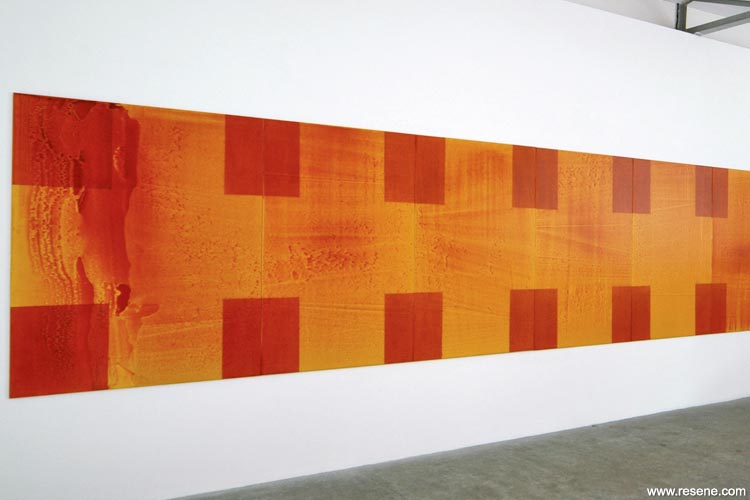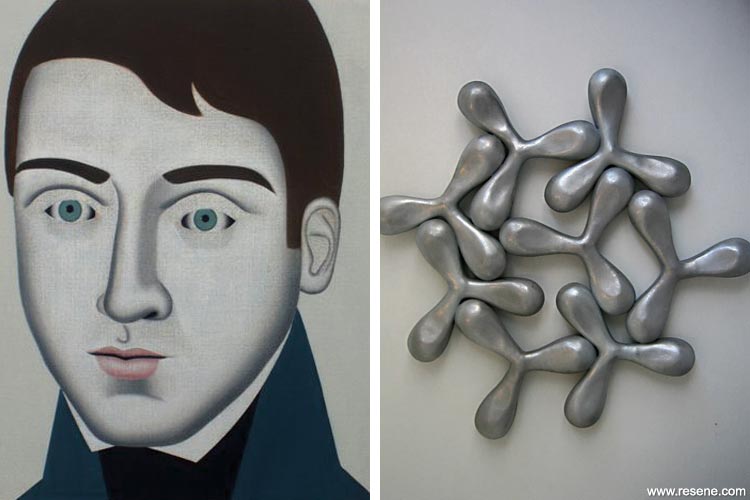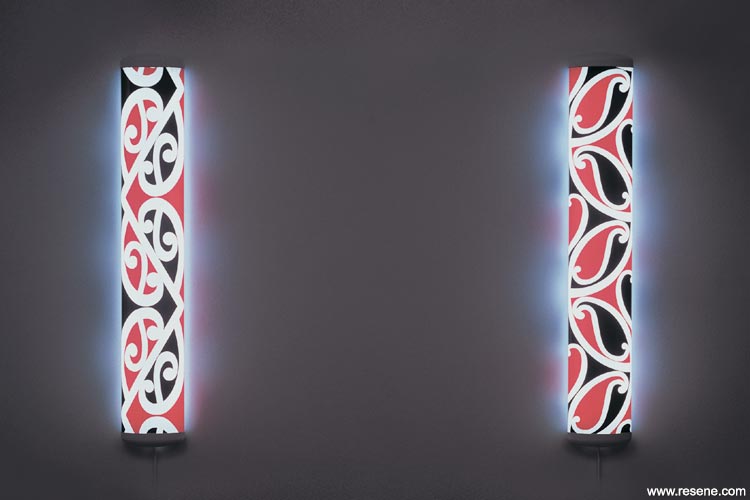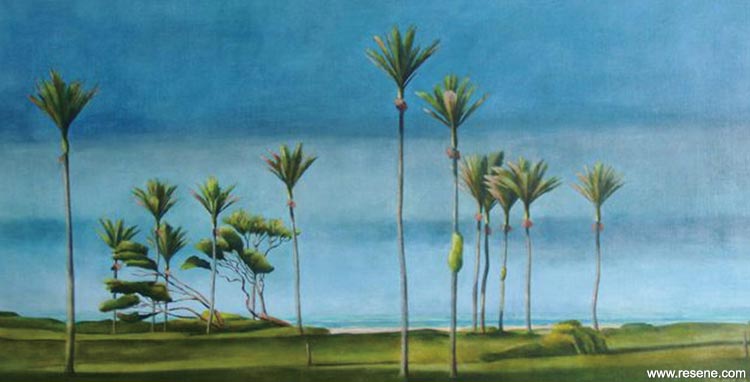A beginners guide to...
From Habitat magazine - issue 02
Know a little about art, but perhaps you’re not confident about your judgment? Do you feel intimidated by the whole notion of buying an original work of art?
Forget the fear factor – it can be fun. Original art can also be a very good investment.
There are a number of art consultants throughout the country who can advise you. Although they are not affiliated to a particular gallery, most will receive a commission from a gallery if they sell a piece of art from one of its artists. So, drawing on the expertise of a consultant, it shouldn’t cost you anything, other than perhaps a fee to cover an initial discussion to establish the brief and confirm the budget. Some consultants may charge for this, based on an hourly rate, much the same as an interior designer.

Chinese Whispers II by Stephan Bambury, Jensen Gallery. Visit Resene’s online art gallery to see how Resene paints have been used in artworks.
Auckland art consultant Lenore West has been buying contemporary New Zealand art for more than 20 years and operating independently for the past four years, working mainly from word-of-mouth referrals for private and corporate clients. She has formed close associations with a range of dealer galleries and artists.
“I like to meet the client in the environment where the art will be installed and establish what the client’s preference is for – paintings, photography, or sculpture. If it’s a painting, we discuss whether the focus will be on landscape, figurative, ethnic, or abstract work. They may wish to introduce a lot of colour into their interior or, alternatively, something monochromatic.”
She has a critical piece of advice for anyone new to purchasing original art.
”Buy something you love. Don’t buy it just because someone tells you to, and please don’t buy art simply because it goes with the sofa. Take the long view. You may move house or the fabric on your sofa may change after a few years. Hopefully, the art you buy will outlast any interior trends.”
There’s no substitute for doing your homework. If you want to pick yourself one special piece of art, or indeed begin to build a collection, you’ll be assisting an artist to make a living from their art by buying an original. If you don’t know where to start, then inform yourself about the local art scene. Develop your eye. Visit both the dealer and public galleries, and make sure you regularly go along to exhibitions.
“Familiarise yourself with what’s going on in the current art market,” advises Anna Bibby of Auckland’s Anna Bibby Gallery. “Talk to the dealers about the artists they represent and get a feel for what you like. You’ll do better if you buy art in an intelligent way.”

Left: Thom, 2004, oil on linen by Gavin Hurley. Right: Propeller by Chiara Corbelletto, Bath Street Gallery.
Anna focuses on emerging and mid-career New Zealand painters, such as Gavin Hurley, Emily Wolfe, Peter Robinson, and younger artists, such as Samantha Mitchell and Tim Thatcher. A lot of dealer galleries have reading copies of catalogues on their artists’ work. Anna has assembled a folder of information on each of her artists, which is available to anyone visiting her gallery.
Reputable art magazines such as Art New Zealand and Art News, both quarterly publications, are well worth reading regularly. There are also several great recently published books about contemporary New Zealand art, including Contemporary Painting in New Zealand by Michael Dunn; Mataora: the living face: contemporary Maori Art, edited by Sandy Adsett, Cliff Whiting and Witi Ihimaera; and Forty Modern New Zealand paintings by Francis Pound. Continuing Education classes run by the universities also provide excellent art lectures from experts such as Helen Hagen and Sue Gardiner, as well as from regular contributing artists.

Michael Parakowhai from the series ‘The Bosom of Abraham’. Image courtesy of the Artist and Michael Lett Gallery. You can browse more modern art from these galleries at bath street gallery.
If you’re buying a painting or a print, good framing is essential to protect the painting. Paintings on canvas may not require framing at all – take advice from a reputable framing service.
For those who don’t have the budget to buy an original painting by an established or even an emerging artist, take heart. There is a strong market for lithographs and screenprints. You can easily pick up limited edition original prints by established artists such as Stanley Palmer, Dick Frizzell and Ralph Hotere.
Christchurch’s PaperGraphica is a gallery that specialises in prints and is attached to a print workshop where it produces limited editions. Its printmakers work with leading artists from all over the country, including John Pule, Kathryn Madill, Philippa Blair, Barry Cleavin and Fatu Feu‘u, producing lithographs, etchings and woodcuts. It has formed long associations with some of the artists – specialist lithograph printer Marian Maguire has been printing Ralph Hotere’s work for almost 20 years.
Print runs range from 20 to 35 copies, and the gallery’s prices range from $200 to $10,000, with the vast majority selling for between $200 and $1500. Prints by artists such as Hotere can start at $5000, and the same goes for artist Bill Hammond.
“We get students who will buy a print on layby and pay it off over a period of months,” says PaperGraphica’s Nigel Buxton. “They’re buying art for the love of it. And if they keep buying over the years, they may well end up one day with a nice collection of prints worth a reasonable amount of money.”

Nikau – Karamea 2004 by Stanley Palmer.
There are also a number of galleries dedicated to the sale of photography, for example the Paul McNamara Gallery in Wanganui, which has work by photographers including Mark Adams, Derek Henderson, Anne Noble, Fiona Pardington, Peter Peryer and Ann Shelton, as well as dozens of others. Most dealer galleries will have one or two photographers in their stables.
Muka Gallery in Auckland, which is well known for its Muka Youth Prints project, was started in the mid-80s by Belgians Frans Baetens and Magda Van Gils. They continue to produce lithographs of the highest standard for leading New Zealand artists.
In other words, don’t just think paintings when you’re looking for your art. Think outside the square. Young artists like Gavin Hurley are making cut-outs. You can purchase ceramics by Peter Collis, or John or Richard Parker; cast glass by Ann Robinson, Emma Camden, or David Murray; blown glass by Stephen Bradbourne, Emily Siddell, or Gary Nash. Sculpture also plays a key role in the New Zealand art scene – think Terry Stringer, Christine Hellyar, or Jacqueline Fraser, to name a few. Another medium is lightboxes – you might like to check out work in this area by Jim Speers or Michael Parakowhai.
There is some superb New Zealand art currently being produced across a vast range of mediums and price ranges by very talented artists. We’ve barely scratched the surface of what’s on offer here. You won’t regret purchasing a piece of original art and it will enhance your environment for many years to come.
The way in which you hang art can make a big difference. Avoid hanging one small picture on a huge expanse of wall. Your art looks better when it seems to extend the lines of furniture, windows or doorways.
Decide where to hang the artwork, keeping in mind the feel you’d like your room to have. Smaller pieces hung together will overwhelm a small room. However, grouping multiple pieces in a larger room adds interest. The right piece of art also makes nooks and crannies more warm and inviting.
Sketching the wall, furniture, and artwork on graph paper before you hang your pictures can help you visualise the final result by conveying the size and the scale of the pieces you are working with.
Large pictures look best centred over sofas or consoles. They are meant to be the focal point of the room and work well in a large wall space.
Also be aware that how you display your art can be as personal as the work itself. For example, you may want to hang a painting where it’s visible to you when seated in your favorite spot.
Once you’ve decided where you’d like to hang your art, measure to find the centres of the piece. Allow for the drop of wire, and make a mark on the wall where you will put the hanger. Choose an appropriate hook. You might want a two-piece nail-and-hook, or a one-piece hook with a disk that keeps the straight part from going completely through the wall. Heavier art should be hung with a hollow-wall anchor. A picture hook will protect your walls and bear the weight of the picture. If this sounds confusing, the easiest thing to do is purchase a picture hanging kit at your local hardware shop. It contains everything you need to hang your art.
Keep your art away from direct sunlight, as anything that will fade your carpet will fade your art. Be careful not to let direct sunlight shine on your art.
Hang your art in neutral climates, away from excessive humidity or dryness. Too much moisture can cause mats and prints to buckle or mould over time. Extreme dryness can also unfavorably affect the artwork
Framing your artwork adds to the life of your art. Be sure to ask for 100% conservation materials when framing your art, such as cotton-rag matboard and acid-free backings. This combination results in the best long-term protection of your art.
Keep an eye out for pollutants and contaminants in the environment. Art is just as susceptible to environmental damage as we are.
Check your framed artwork about every six months, front and back, for signs of damage such as cracking and mould. Paper conservators may be able to repair any damage that has been done and help you with preventative maintenance for the future.
Do not spray cleaner of any kind directly onto the framed piece. Rather, spray cleaner onto a cloth and then apply it to the glass or perspex.
words: Sue Reidy
Search habitat magazine stories
Printed copies of habitat highlights are available from late March 2024 at Resene ColorShops and resellers, while stocks last. You can view back issues of habitat magazine online.
Specifiers:
If you have an idea, project or story that you think would suit habitat, we’d love to hear from you. Please drop us an email with your details and include photos if submitting a project.
Sign up for a DIY card and Save! Australia | New Zealand